

Here is an entertaining comparatives and superlatives game to help students practice comparative and superlative forms of basic adjectives. First, students complete questions with the comparative or superlative form of the adjectives in brackets. Next, in pairs, students guess their partner's answers to the questions and write them down in the 'My Guesses' column. Students then take turns asking the questions to their partner, who answers truthfully. The other student then writes their partner's answer in the next column. If the student guessed correctly, they score a point. The student with the most points at the end of the game wins.
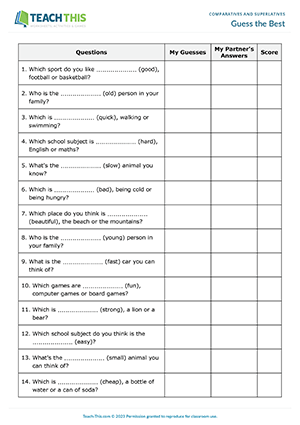


In this rewarding comparatives and superlatives game, students practice making comparative and superlative sentences with various nouns and adjectives. In pairs, students take turns picking up a noun card containing three nouns. The student then has 30 seconds to find a matching adjective card and make three sentences using all the nouns and adjectives on both cards. For example, if a student picks up a noun card with village, town and city, they might select the adjective card with large, larger, and largest, and make the following sentences: A village is large. A town is larger than a village. A city is the largest. If the student makes three sentences using all the nouns and adjectives on the cards within the time limit, they keep both cards. If a student cannot make three sentences within the time limit, they place the noun card at the bottom of the pile and put the adjective card back in its place. The student with the most cards at the end of the game wins.
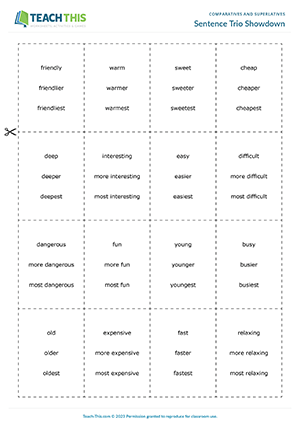


In this free comparatives and superlatives game, students complete questions with comparative or superlative adjectives and then predict a partner's answers to the questions. In two groups, students complete questions on their worksheet with the correct comparative or superlative form of the adjectives in brackets. Next, each student pairs up with someone from the other group. Without talking, students predict their partner's answers to the questions and write them down on the worksheet. Students then take turns asking and answering the questions and comparing their partner's answers with the predictions. For each correct prediction, students score a point. The student with the most points at the end of the game wins.
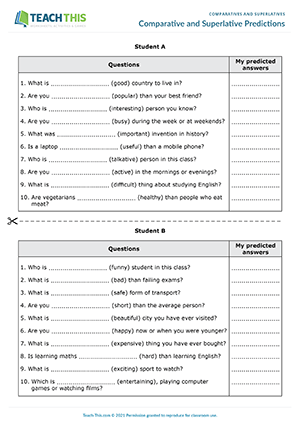


In this creative comparatives and superlatives game, students make sentences about different countries. First, the class names as many adjectives as they can and you write them on the board. Next, students name ten countries. These are also written on the board. Teams then have ten minutes to make as many comparative and superlative sentences as they can using the adjectives and countries listed on the board, e.g. 'Thailand is hotter than Germany.' After the ten-minute time limit has been reached, the teams read out their sentences. Teams score one point for each grammatically correct and appropriate sentence. Play further rounds by asking the students to name other categories such as sports, animals, famous people, etc. The team with the most points at the end of the game wins.
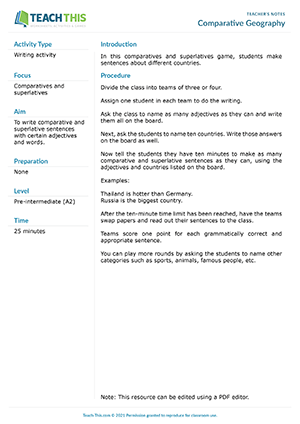


This productive comparatives and superlatives worksheet helps students learn and practice comparative and superlative adjectives and sentence structure. Students begin by reading information about how comparative and superlative adjectives are formed. Students then test their knowledge of irregular comparative and superlative adjectives. Students then write the comparative and superlative forms of adjectives using the information about how they are formed. Next, students complete questions and answers with the comparative or superlative forms of the adjectives in brackets and their own answers. Students then go on to create one comparative and one superlative conversation question of their own and answer them. When the students have finished, they ask and answer the questions from the last two exercises with a partner. Finally, students say which things they prefer from two choices, explaining their answers using comparatives.
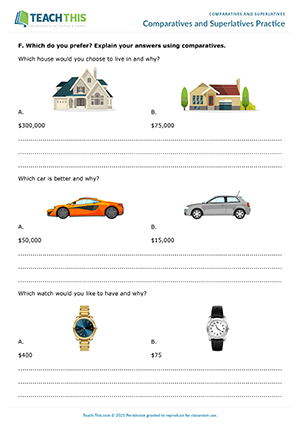


In this engaging comparatives and superlatives worksheet, students take part in a quiz where they order things and write comparative and superlative sentences about them. First, students put words in order, according to the adjectives in brackets. Students then write sentences using the words and adjective in its comparative and superlative form. When everyone has finished, check the correct answers with the class.
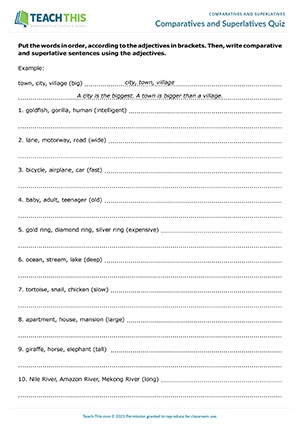


In this insightful comparatives and superlatives activity, students conduct a survey and then write comparative and superlative sentences about the results. To begin, students answer six questions, writing their answers in a table. In groups, students then interview the other members of the group using the six questions and complete the table with their answers. When the students have finished, they use the results to write three comparative and three superlative sentences about the students in their group. Finally, students compare their sentences and give feedback to the class on what they found out.
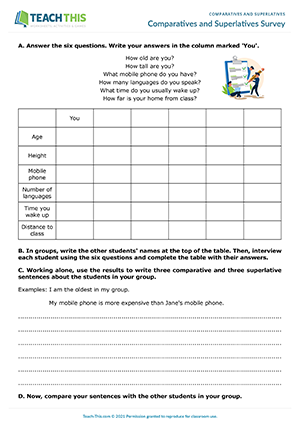


Here is an inventive comparatives and superlatives game for students to play in class. Students take turns turning over two cards from the same category and making a comparison between the two words on the back of the cards. For example, if a student turned over two animal cards and the two words were 'tiger' and 'mouse', the student might say 'A tiger is more dangerous than a mouse.' If a student turns over two identical words, they make a superlative sentence. If a student successfully makes a comparative or superlative sentence, they keep the two cards. If a student cannot think of a sentence or their sentence is grammatically incorrect, they put the cards back and miss a turn. The student with the most cards at the end of the game is the winner.
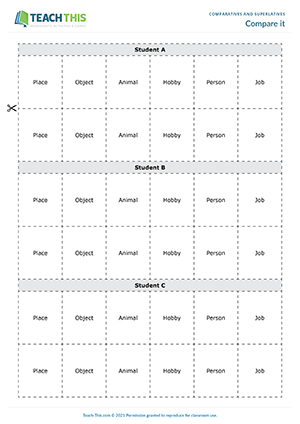


In this free comparatives and superlatives activity, students draw pictures of three people from comparative and superlative descriptions of their appearance. First, students read comparative and superlative sentences that describe three classmates. After reading the sentences, students draw pictures of the three classmates from the descriptions and compare their pictures with a partner. As an extension, students write comparative and superlative descriptions of three students in their class and then dictate the descriptions to a partner for them to draw.
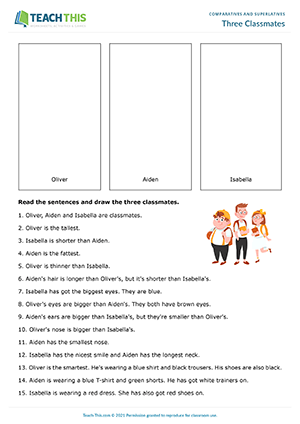


This fun comparatives and superlatives board game helps students practice making comparative and superlative sentences by giving opinions and stating facts. Students take turns rolling the dice and moving their counters along the board. When a student lands on a shaded square, they make a comparative sentence using the adjective and two things shown on the square, e.g. 'Wine is stronger than beer.' When a student lands on a white square, they make a comparative and superlative sentence using the adjective and three things shown, e.g. 'In my opinion, cars are safer than motorbikes. I think that bicycles are the safest way to travel.' The other group members listen to the student and decide if what they say is grammatically correct or not. If it is, the student stays on the square. If not, the student goes back two squares. The first student to reach the finish wins the game.
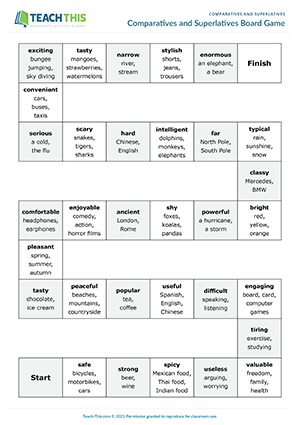


In this interesting comparatives and superlatives game, students race to find as many people as they can who fit comparative and superlative descriptions. Each student draws a slip from a box. Students read the comparative or superlative description on their slip and think about the question they need to ask to find people who fit that description. For example, if the slip reads 'Find people who are the oldest children in their families', the student might ask 'Are you the oldest child in your family?' When the students have their questions prepared, they race to find as many people as they can who fit their description. When a student finds someone who matches the description, they write down their name on the back of the slip. When a time limit has been reached, students say how many people they found who matched their description. Students score one point for each person they find. Students then draw another slip from the box and continue as before. The student with the most points at the end of the game wins.
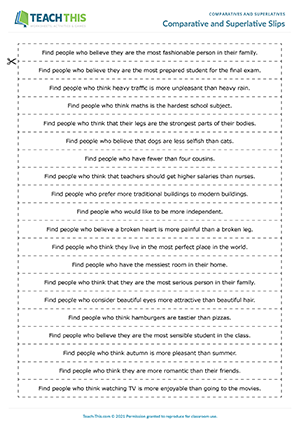


This imaginative comparatives and superlatives game helps students practice making comparative and superlative sentences with a range of adjectives. Students take turns choosing a topic and taking an adjective card from the pile. The student then makes a comparative and superlative sentence using the adjective on the card. The two sentences must be related to the topic. If a student manages to do this, they score two points. If a student cannot make two sentences, or one or both sentences are grammatically incorrect, the adjective card goes to the next player and they try to make two sentences about the topic for four points, and so on, adding two points each time. The student with the highest score at the end of the game wins.
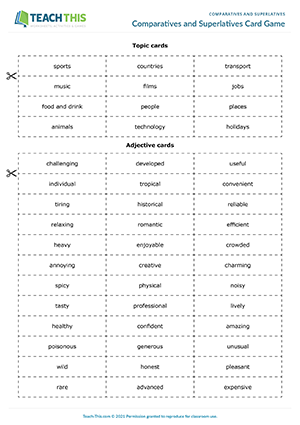


This enjoyable comparatives and superlatives speaking activity helps students practice forming, asking and answering comparative and superlative conversation questions. First, in two groups, students complete each conversation question with the comparative or superlative form of the adjective in brackets, plus than or the where appropriate. Students then pair up with someone from the other group and take turns asking and answering the conversation questions with their partner, responding with the comparative or superlative form of the adjective, according to the question. Finally, students share what they found out about their partner with the class.
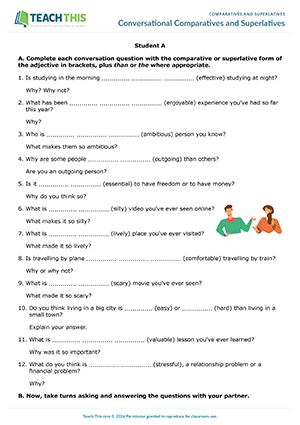


In this free comparatives and superlatives questionnaire activity, students complete a preferences questionnaire and then discuss them with a partner using comparatives and superlatives. First, students read each question on the worksheet and order the items, according to their preferences. Students mark number 1 for what they prefer the most and number 3 for what they prefer the least. In pairs, students then discuss their preferences with their partner using comparatives and superlatives. Afterwards, students give feedback to the class by explaining their preferences.
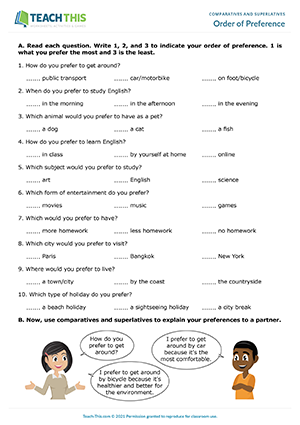


In this memorable comparatives and superlatives speaking activity, students complete a variety of comparative and superlative questions and then ask and answer them with a partner. First, in two groups, students complete comparative and superlative question strips with their own ideas using each comparative or superlative adjective once. Students then pair up with someone from the other group, shuffle their own question strips and place them in a pile in front of them. Next, students take turns picking up one of their question cards and asking the question to their partner, who replies accordingly. Students also ask follow-up questions to gain more information. Afterwards, students tell the class what they found out about their partner..
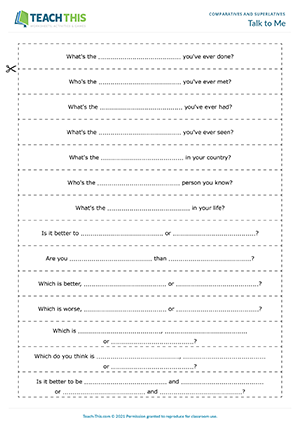


This useful comparatives and superlatives worksheet helps students practice a variety of comparative and superlative adjectives related to dogs and other pets. Students start by reading a chart that contains information about four large dog breeds. Students then read comparative and superlative statements about the dogs and mark them as true or false, correcting the false sentences to make them true by changing the names of the dogs or by making the sentences negative. Next, students complete sentences with the comparative or superlative form of the adjectives or phrases in brackets. Finally, students answer questions about the dogs by writing comparative or superlative sentences.